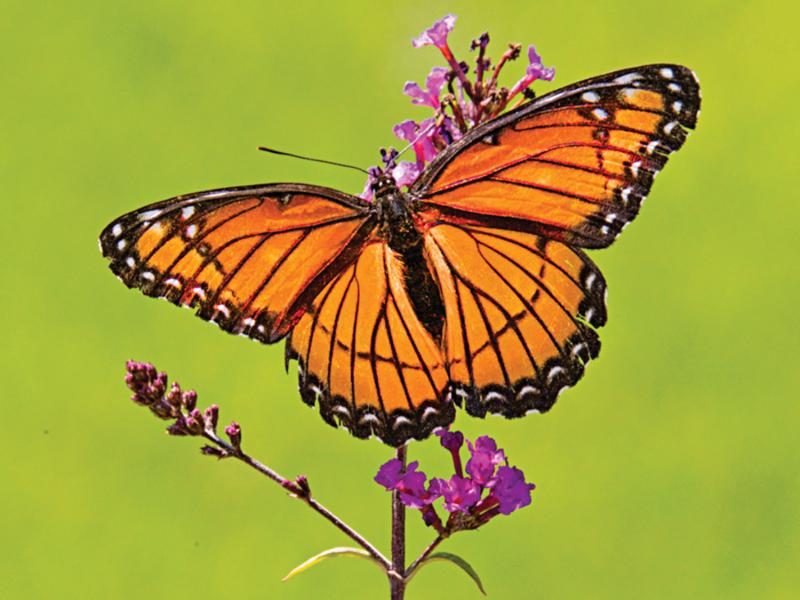An orange butterfly we recently saw in the distance looked like a monarch—but might actually have been a viceroy. To definitively distinguish the look-alikes, you have to get close enough to check for a black ribbon band running across the hind wings: viceroys have them, monarchs don’t. Our images this month include both viceroys and monarchs for a side-by-side, top-and-bottom comparison. For a more distant clue, observe the flight patterns. The monarch’s is more of a flap, flap, and glide; the viceroy is more frenetic in its movements.
Ronda Spink, the Michigan Butterfly Network coordinator, says that experts used to think that viceroys mimicked monarchs because monarchs taste bitter, making them less susceptible to avian predators. But a blackbird taste test reported in 1991 revealed that viceroys are bitter, too. Science now regards these two as co-mimics.
Matthew Douglas, a butterfly expert who teaches at Grand Rapids Community College and Michigan State University, enthusiastically told a further tale of co-mimicry. When the viceroy is found in Florida and other southern states, it looks more like a queen—a southern butterfly that also resembles a monarch but is much darker. In states where queens are present, viceroys are darker, too. Birds beware: all orange butterflies taste bad.
While viceroys are holding their own, monarch populations are in severe decline. Last year, we could hardly find a monarch, but we could almost always find a viceroy or two at Matthaei Botanical Gardens.
Viceroys aren’t as well known as monarchs, but they have a couple of environmental advantages: monarchs depend upon scarce milkweed as host plants for their caterpillars, while viceroys favor abundant willows, poplars, and cottonwoods. And while monarchs overwinter in Mexico, viceroys are homebodies, wintering right here in caterpillar form. According to Spink, late in the year, when a viceroy is in the second of its five caterpillar stages or “instars,” it takes a leaf of its host plant and rolls it into a tube that is held together and attached tightly to the host plant with caterpillar silk. The caterpillar then crawls inside and goes to sleep for the winter.
Come spring, the caterpillar emerges and continues to eat the host plant’s leaves as it moves through three more instars. The fifth instar encapsulates itself in a chrysalis from which the adult viceroy will emerge. Barring predation, disease, or other bad luck, the adult will have a life span of two or three weeks, during which time the female will deposit eggs on the tips of leaves of its host plant. These will hatch into first instars, and the cycle of butterfly life will progress on. Usually there will be two flights of viceroys each summer.
Douglas suggests looking for viceroys by creeks with willows, poplars, or cottonwoods. Washtenaw County Parks naturalist Shawn Severance reminded us that native willows occur as shrubs as well as trees; she suggests looking in the Malletts Creek area of County Farm Park. Other good public spaces to look for viceroys, according to city natural area preservation stewardship specialist Becky Gajewski, include Olson Park, Barton Nature Area, Furstenberg Nature Area, Dhu Varren Woods Nature Area, South Pond Nature Area, and Gallup Park. And don’t forget Matthaei Botanical Gardens, one of our favorite butterfly haunts.


